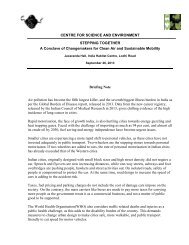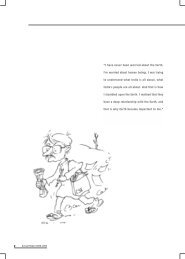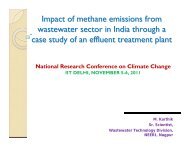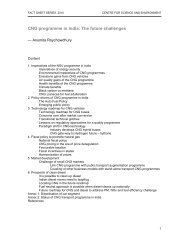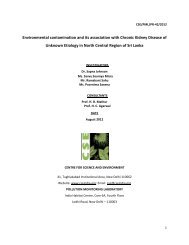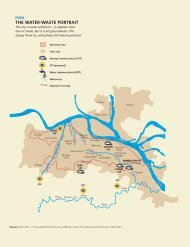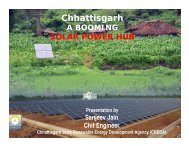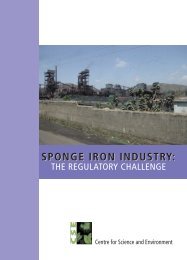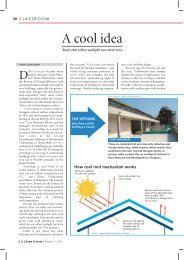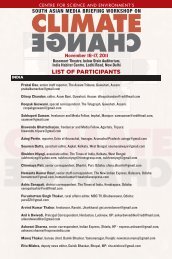Endosulfan - Centre for Science and Environment
Endosulfan - Centre for Science and Environment
Endosulfan - Centre for Science and Environment
Create successful ePaper yourself
Turn your PDF publications into a flip-book with our unique Google optimized e-Paper software.
snehasanthwanam Page 2
REPORT ON HEALTH EFFECTS OF ENDOSULFAN<br />
AND PROGRESS OF REHABILITATION ACTIVITIES<br />
IN KERALA<br />
Department of Health <strong>and</strong> family welfare, Government of Kerala<br />
20 th April 2011<br />
snehasanthwanam Page 3
snehasanthwanam Page 4
snehasanthwanam Page 5
snehasanthwanam Page 6
snehasanthwanam Page 7
snehasanthwanam Page 8
History <strong>and</strong> Background<br />
Introduction<br />
<strong>Endosulfan</strong>, a highly toxic organochlorine pesticide was sprayed in the cashew plantations in Kasaragod<br />
District since 1978, till 2001 regularly three times every year. The aerial spraying of <strong>Endosulfan</strong> was<br />
undertaken to contain the menace of the tea mosquito bug.<br />
As early as 1979, stunted growth <strong>and</strong> de<strong>for</strong>med limbs were noticed among new born calves. By 1990s<br />
health disorders of very serious nature among the human population came to the lime light. Children<br />
were found to be the worst affected with congenital anomalies, mental retardation, physical<br />
de<strong>for</strong>mities, cerebral palsy, epilepsy, hydrocephalus etc. Men <strong>and</strong> women were also affected<br />
with various chronic ailments, many irreversible <strong>and</strong> difficult to treat. From the mid of 1990’s, the<br />
community living near plantations had been complaining against the spraying of <strong>Endosulfan</strong>.<br />
Enquiry Commissions<br />
Govt of Kerala <strong>and</strong> Govt. of India had appointed 11 various commissions to inquire about the issue.<br />
Various Non-Government Organizations also made some studies at their own level. Most of the studies<br />
revealed the hazards of <strong>Endosulfan</strong> use <strong>and</strong> its impact on the food, water <strong>and</strong> beverages.<br />
These enquiry reports in one way or other infer that pesticide <strong>Endosulfan</strong> is responsible <strong>for</strong><br />
the horrendous mutations <strong>and</strong> ailments that many in the villages of Kasaragod district are<br />
suffering <strong>for</strong>m. From 2000 onwards committees of various departments, Non-Governmental<br />
Organizations, Indian Council of Medical Research <strong>and</strong> other agencies conducted visits to the<br />
area <strong>and</strong> submitted reports to the Government regarding this issue.<br />
snehasanthwanam Page 9
Prominent among them are:<br />
1. Committee appointed by Kerala Agricultural University with Dr. Abdul Salam as Chairman.<br />
2. Committee appointed by Government of Kerala with Dr. Achuthan as Chairman.<br />
3. Committee from National Institute of Occupational Health, ICMR, Ahemedabad.<br />
Following reports in public domain have been published which are available on website<br />
www.endosulphanvictims.org<br />
The major conclusions of NIOH (under ICMR) in 2002 were:<br />
There is significantly higher prevalence of neurobehavioural disorders, congenital mal<strong>for</strong>mations in<br />
female subjects <strong>and</strong> abnormalities related to male reproductive system in the study group (Padre<br />
village, Enmakaje Panchayat) as compared to the reference group (Miyapavadu village of Meenja<br />
Panchayat).<br />
Regarding the aetiological factors, responsible <strong>for</strong> these health problems, various factors were<br />
compared <strong>and</strong> it was found that the two groups differed mainly with respect to exposure to<br />
endosulfan.<br />
Court Orders:<br />
A victim, Smt. Leela Kumari Amma approached a lower court (Munsif Court, Hosdurg) in 2001 <strong>and</strong><br />
the court temporarily stayed aerial spraying of <strong>Endosulfan</strong> in Cashew plantations. In 2003, the<br />
High Court of Kerala upheld the order of lower court <strong>and</strong> it permanently stopped <strong>Endosulfan</strong> spraying.<br />
Since then, the Govt.of Kerala imposed a ban on the use of <strong>Endosulfan</strong>.<br />
snehasanthwanam Page 10
Adding to these the Government of Kerala ordered <strong>for</strong> three scientific<br />
studies in 2010:<br />
1. Calicut Medical College: <strong>for</strong> epidemiological study: Submitted preliminary<br />
report.<br />
2. Rajiv Gh<strong>and</strong>i <strong>Centre</strong> <strong>for</strong> Biotechnology: <strong>for</strong> genetic study. : Proposal submitted.<br />
3. Kerala state council <strong>for</strong> science <strong>and</strong> technology <strong>for</strong> environmental study<br />
Major conclusion of the epidemiological study by Calicut Medical College (Dec 2010- Jan 2011):<br />
• The reproductive health events including infertility, precocious puberty, abortion, intra<br />
uterine death (IUD)/ still birth, neonatal/ child death were found significantly higher in<br />
study population when compared to control population.<br />
• Among the youth population (below the age of 40-) the rate of surgery <strong>for</strong> any heart<br />
diseases , hernia <strong>and</strong> genito urinary causes were higher in area study group than<br />
control group.<br />
• When the prevalence of morbidity in adolescents were assessed it was found that any<br />
organ anomaly , birth defects, congenital heart disease, seizure, skin problems <strong>and</strong><br />
reproductive disorders were significantly higher in study group when compared to<br />
control groups.<br />
snehasanthwanam Page 11
2. Rehabilitation: ‘snehasanthwanam’ progress till date<br />
HEALTH SECTOR<br />
1. Identification of patients <strong>and</strong> scientific evaluations:<br />
Though the ef<strong>for</strong>ts <strong>for</strong> identification of endosulfan victims were on from 2003, an<br />
active search <strong>for</strong> affected patients started in later half of 2010.<br />
Progress till date:<br />
1.1Two house to house surveys <strong>and</strong> series of specialty medical camps were<br />
conducted in November, December 2010 <strong>and</strong> January 2011:<br />
A. Socioeconomic survey: primarily aimed at ascertaining the economic status<br />
, loss of livelihood due to ailments , loan indebtness , patient status , loss of<br />
education , problems in getting married due to social stigma <strong>and</strong> other such<br />
issues.<br />
B. Health survey: <strong>for</strong> identifying self-reported ailments in the affected<br />
panchayats. This was done by health workers <strong>and</strong> ASHA volunteers.<br />
C. Specialty Medical camps:<br />
Though the health survey gave a bird’s eye view of disease load of the<br />
affected areas, it failed to identify specific ailments. So it was decided that the<br />
snehasanthwanam Page 12
est available experts should be pooled in to conduct specialty medical camps<br />
with following objectives:<br />
o To identify endosulfan medical victims, diagnose their specific ailments,<br />
prescribe long-term treatment <strong>for</strong> them by a team of expert medical<br />
colleges.<br />
o To quantify <strong>and</strong> keep an account of all required treatments <strong>and</strong> the<br />
institutions from which these treatments can be availed.<br />
o To enroll patients <strong>for</strong> providing treatment smart card <strong>and</strong> prioritize the<br />
need <strong>for</strong> specialized care.<br />
snehasanthwanam Page 13
Conduct of camps:<br />
One specialty Medical camps were conducted in each panchayat from 16.12.2010<br />
to 09.01.2011 in all the affected 11 Panchayaths, followed by 1 ‘mop up’ camps<br />
<strong>for</strong> two panchayat, taking the toll of specialty camps to 17.<br />
About 125specialist from Govt. Medical Colleges <strong>and</strong> 175 doctors from health<br />
services were roped in to the camps.<br />
Camp pattern was as follows:<br />
• Registration: There were 8-10 registration counters with 3 staff at each<br />
counter. Details of all patients were meticulously registered. The patients<br />
were provided with 2 <strong>for</strong>ms (enclosed as annexure ):<br />
a. Form 1: <strong>for</strong> details of the clinical condition <strong>and</strong> treatment suggested,<br />
which was entered <strong>and</strong> analyzed using SPSS after the camps.<br />
b. Form 2: drug prescription <strong>for</strong>ms which were given to the patient.<br />
• Screening: 10 to 15 general practitioners from health service screened the<br />
registered patients <strong>and</strong> referred them to respective specialty clinics (may be<br />
more than one). ASHA workers <strong>and</strong> volunteers directed <strong>and</strong> often<br />
accompanied the patients to the specialty clinics.<br />
• Specialty clinics: Separate rooms were provided <strong>for</strong> each specialty clinic.<br />
Apart from specialists each consultation rooms were provided with:<br />
snehasanthwanam Page 14
c. Two nursing students or one staff nurse + one nursing student<br />
d. One field staff<br />
e. Nursing assistant (in O&G) <strong>and</strong> refractionist (in Ophthalmology)<br />
f. General equipments <strong>and</strong> facilities including BP apparatus, Steth,<br />
Torch, antiseptic h<strong>and</strong> rub/wash, tissue paper<br />
g. Specialized equipments like: ophthalmoscope, slit lamp, tuning <strong>for</strong>k,<br />
knee hammer etc<br />
The specialties included:<br />
Sl no Specialty No. of specialist at each camp site<br />
1 General Medicine 2 to 4<br />
2 Neurology 3 to 4<br />
3 Gynecology 2<br />
4 ENT 2<br />
5 Psychiatry 2<br />
6 Dermatology 2<br />
7 Orthopedics 2<br />
snehasanthwanam Page 15
8 Ophthalmology 2<br />
9 Oncology 1-2<br />
10 Surgery 2<br />
11 Pediatrics 2<br />
12 Chest diseases 1-2<br />
• Lab: Facilities were provided <strong>for</strong> routine investigations. Patients requiring<br />
advanced investigations will be availed the same after consolidation.<br />
• Pharmacy: For the drugs not available at Pharmacy, a register was<br />
maintained <strong>and</strong> ef<strong>for</strong>ts are on to supply it to the patient as soon as possible.<br />
• Lunch <strong>and</strong> refreshment: Lunch <strong>and</strong> light refreshment will be provided here<br />
<strong>for</strong> doctors (in rotation), staff <strong>and</strong> volunteers at 11 am <strong>and</strong> lunch at 2pm.<br />
Patients who had to wait afternoon were provided lunch in the third <strong>and</strong><br />
fourth camps. This may be replicated elsewhere.<br />
Transport of patients: 10 Vehicles (including 2 ambulances) were provided <strong>for</strong> to <strong>and</strong><br />
fro transportation of patients. Health worker or ASHAs accompanied the patients<br />
whenever warranted. Special care was taken to ensure public participation <strong>and</strong> the<br />
involvement <strong>and</strong> cooperation of LSG institutions were inspiring.<br />
snehasanthwanam Page 16
Dates Panchayats<br />
16-12-10 Kayyur Chemeni<br />
17-12-10 Muliyar<br />
18-12-10 Enmagaje<br />
19-12-10 Panathur<br />
06-01-11 Periya<br />
07-01-11 Bellor<br />
08-01-11 Kumbadaje<br />
09-01-11 Badiyaduka<br />
10-01-11 Kallar, Enmagaje, Kumbadaje (3camps)<br />
11-01-11 Mulleria, Pullur, Kayyur (3camps)<br />
12-01-11 Ajanur, Muliyar, Kallar (3camps)<br />
Total number of patients attended in the camps: 15698<br />
snehasanthwanam Page 17
The scientific basis <strong>for</strong> including a disease as due<br />
to endosulfan<br />
Probable <strong>Endosulfan</strong> victim: Inclusion criteria:<br />
The history, diagnosis <strong>and</strong> treatment required were entered in SPSS <strong>and</strong><br />
analyzed using PASW. The factors which were considered <strong>for</strong> labeling a<br />
case as suspected endosulfan victims are as follows:<br />
1. History of Exposure: This can be :<br />
a) Occupational<br />
b) Non- occupational<br />
c) Mother to child through placenta <strong>and</strong> breast milk<br />
(Details in monograph on endosulfan enclosed as annexure)<br />
2. Evidence based:<br />
Based on evidence from over 140 published studies about health<br />
effects of endosulfan, from various parts of the world.<br />
(References attached as annexure 1)<br />
However the benefit of doubt favored the patients.<br />
snehasanthwanam Page 18
From the systematic literature review of scientific journals published in<br />
peer reviewed journals, it became evident that, not only the association<br />
between endosulfan <strong>and</strong> its health effects, but also even the mechanism by<br />
which it harms the body is also established:<br />
1. <strong>Endosulfan</strong> affects nervous system of even during gestational<br />
period.<br />
snehasanthwanam Page 19
Effects on Nervous system: published studies<br />
1. Alexs<strong>and</strong>rowicz DR. 1979. <strong>Endosulfan</strong> poisoning <strong>and</strong> chronic brain syndrome. Arch<br />
Toxicol 43:65-8.<br />
2. Benamú MA, Schneider MI, Pineda S, Sanchez NE, Gonzalez A. 2007. Sublethal effects of<br />
two neurotoxican insecticides on Araneus pratensis (Araneae: Araneidae). Commun<br />
Agric Appl Biol Sci 72(3):557-9.<br />
3. Cabaleiro T, Caride A, Romero A, Lafuente A. 2008. Ef Neurotoxicol Teratol 24(6):797-<br />
804.fects of in utero <strong>and</strong> lactational exposure to endosulfan in prefrontal cortex of male<br />
rats. Toxicol Letts 176:58–67.<br />
4. Castillo, CG, Montante M, Dufour L, Martínez ML, Jiménez-Capdeville ME. 2002.<br />
Behavioral effects of exposure to endosulfan <strong>and</strong> methyl parathion in adult rats.<br />
5. Dutta H, Arends DA. 2003. Effects of endosulfan on brain acetylcholinesterase activity in<br />
juvenile bluegill sunfish. Environ Res 91:157–62.<br />
6. Damgaard IN, Skakkebaek NE, Toppari J, Virtanen HE, Shen H, Schramm KW, Petersen<br />
JH, Jensen TK, Main KM, Nordic Cryptorchidism Study Group. 2006. Persistent<br />
pesticides in human breast milk <strong>and</strong> cryptorchidism. Environ Health Perspect.<br />
114(7):1133-8<br />
7. Gormley KL, Teather KL. 2003. Developmental, behavioral, <strong>and</strong> reproductive effects<br />
experienced by Japanese medaka (Oryzias latipes) in response to short-term exposure to<br />
endosulfan. Ecotox Environ Saf 54:330-38.<br />
8. Jia Z, Misra HP. 2007a. Developmental exposure to pesticides zineb <strong>and</strong>/or endosulfan<br />
renders the nigrostriatal dopamine system more susceptible to these environmental<br />
chemicals later in life. Neurotoxicology 28(4):727-35.<br />
9. Pradhan S, P<strong>and</strong>ey N, Phadke RV, Kaur A, Sharma K, Gupta RK. 1997. Selective<br />
involvement of basal ganglia <strong>and</strong> occipital cortex in a patient with acute endosulfan<br />
poisoning. J Neurol Sci 147(2):209-13.<br />
10. Roberts DM, Dissanayake W, Sheriff MHR, Eddeston M. 2004. Refractory status<br />
epilepticus follow self-poisoning with the organochlorine pesticide endosulfan. J Clin<br />
Neurosci 11(7):760-62.<br />
11. Roberts EM, English PB, Grether KJ, Windham GC, Somberg L, Wolff C. 2007. Maternal<br />
residence near agricultural pesticide applications <strong>and</strong> autism spectrum disorders among<br />
children in the Cali<strong>for</strong>nia Central Valley. Environ Health Perspect 115(10):1482-9.<br />
12. Wang XF, Li S, Chou AP, Bronstein JM. 2006a. Inhibitory effects of pesticides on<br />
proteasome activity: implication in Parkinson's disease. Neurobiol Dis 23(1):198-205.<br />
13. Vale C, Fonfria E, Bujons J, Messeguer A, Rodriguez-Farre E, Sunol C. 2003. The<br />
organochlorine pesticides gamma-hexachlorocyclohexane (lindane), alpha-endosulfan<br />
<strong>and</strong> dieldrin differentially interact with GABA(A) <strong>and</strong> glycine-gated chloride channels<br />
in primary cultures of cerebellar granule cells. Neuroscience 117(2):397-403.<br />
snehasanthwanam Page 20
2. <strong>Endosulfan</strong> affects reproduction:<br />
snehasanthwanam Page 21
Effects on reproductive system: published studies<br />
1. Andersen HR, Vinggaard AM, Rasmussen TH, Gjerm<strong>and</strong>sen IM, Bonefeld-Jorgensen<br />
EC. 2002. Effects of currently used pesticides in assays <strong>for</strong> estrogenicity, <strong>and</strong>rogenicity,<br />
<strong>and</strong> aromatase activity in vitro. Toxicol Appl Pharmacol 179(1):1-12.<br />
2. Burke ER, Holden AJ, Shaw IC. 2003. A method to determine residue levels of persistent<br />
organochlorine pesticides in human milk from Indonesian women. Chemosphere<br />
50(4):529-35.<br />
3. Pathak R, Suke SG, Ahmed T, Ahmed RS, Tripathi AK, Guleria K, Sharma CS, Makhijani<br />
SD, Banerjee BD. 2010. Organochlorine pesticide residue levels <strong>and</strong> oxidative stress in<br />
preterm delivery cases. Hum Exp Toxicol 2010 29(5):351-8.<br />
4. Koç ND, Kayhan FE, Sesal C, Muşlu MN. 2009. Dose-dependent effects of endosulfan<br />
<strong>and</strong> malathion on adult Wistar albino rat ovaries. Pak J Biol Sci 12(6):498-503.<br />
5. Campoy C, Jimenz M, Olea-Serrano MF, Moreno-Frias M, Canabate F, Olea N, Bayes R,<br />
Molina-Font JA. 2001. Analysis of organochlorine pesticides in human milk: preliminary<br />
results. Early Hum Devel 65(s2):S183-190.<br />
6. Cerrillo I, Granada A, Lopez-Espinosa MJ, Olmos B, Jimenez M, Cano A, Olea N, Fatima<br />
Olea-Serrano M. 2005. <strong>Endosulfan</strong> <strong>and</strong> its metabolites in fertile women, placenta, cord<br />
blood, <strong>and</strong> human milk. Environ Res 98(2):233-39.<br />
7. Cossette LJ, Gaumond I, Martinoli MG. 2002. Combined effect of xenoestrogens <strong>and</strong><br />
growth factors in two estrogen-responsive cell lines. Endocrine 18(3):303-8.<br />
8. Dalsenter PR, Dallegrave E, Mello JR, Langeloh A, Oliveira TR, FaqiAS. 1999.<br />
Reproductive effects of endosulfan on male offspring of rats exposed during pregnancy<br />
<strong>and</strong> lactation. Hum Exp Toxicol 18(9):583-89.<br />
9. Damgaard IN, Skakkebaek NE, Toppari J, Virtanen HE, Shen H, Schramm KW, Petersen<br />
JH, Jensen TK, Main KM, Nordic Cryptorchidism Study Group. 2006. Persistent<br />
pesticides in human breast milk <strong>and</strong> cryptorchidism. Environ Health Perspect.<br />
114(7):1133-8.<br />
10. Dutta HM, Misquitta D, Khan S. 2006. The effects of endosulfan on the testes of bluegill<br />
fish, Lepomis macrochirus: a histopathological study. Arch Environ Contam Toxicol<br />
51(1):149-56.<br />
11. Foster WG, Agarwal SK. 2002. <strong>Environment</strong>al contaminants <strong>and</strong> dietary factors in<br />
endometriosis. Ann NY Acad Sci 955(1):213-29.<br />
12. Fukata H, Omori M, Osada H, Todaka E, Mori C. 2005. Necessity to measure PCBs <strong>and</strong><br />
organochlorine pesticide concentrations in human umbilical cords <strong>for</strong> fetal exposure<br />
assessment. Environ Health Perspect 113:297-303.<br />
13. Garg UK, Pal AK, Jha GJ, Jadhao SB. 2004. Haemato-biochemical <strong>and</strong> immunopathophysiological<br />
effects of chronic toxicity with synthetic pyrethroid,<br />
organophosphate <strong>and</strong> chlorinated pesticides in broiler chicks. Int Immunopharmacol<br />
4(13):1709-22.<br />
14. Grunfeld HT, Bonefeld-Jorgensen EC. 2004. Effect of in vitro estrogenic pesticides on<br />
human oestrogen receptor alpha <strong>and</strong> beta mRNA levels. Toxicol Lett 151(3):467-80.<br />
snehasanthwanam Page 22
15. Hiremath MB, Kaliwal BB. 2002. The anti-implantation action of endosulfan in albino<br />
mice: possible mechanisms. J Basic Clin Physiol Pharmacol 13(4):329-40.<br />
16. Kojima H, Katsura E, Takeuchi S, Niiyama K, Kobayashi K. 2004. Screening <strong>for</strong> estrogen<br />
<strong>and</strong> <strong>and</strong>rogen receptor activities in 200 pesticides by in vitro reporter gene assays using<br />
Chinese hamster ovary cells. Environ Health Perspect 112(5):524-31.<br />
17. Lemaire G, Mnif W, Mauvais P, Balaguer P, Rahmani R. 2006. Activation of alpha- <strong>and</strong><br />
beta-estrogen receptors by persistent pesticides in reporter cell lines. Life Sci 79(12):1160-<br />
9.<br />
18. Li X, Zhang S, Safe S. 2006a. Activation of kinase pathways in MCF-7 cells by 17Bestradiol<br />
<strong>and</strong> structurally diverse estrogenic compounds. J Steroid Biochem Mol Biol 98(2-<br />
3):122-32.<br />
19. Lutter C, Iyengar V, Barnes R, Chuvakova T, Kazbekova G, Sharmanov T. 1998. Breast<br />
milk contamination in Kazakhstan: implications <strong>for</strong> infant feeding. Chemosphere 37(9-<br />
12):1761-72.<br />
20. Palma P, Palma VL, Fern<strong>and</strong>es RM, Soares AMVM, Barbosa IR. 2008. <strong>Endosulfan</strong><br />
sulphate interferes with reproduction, embryonic development <strong>and</strong> sex differentiation in<br />
Daphnia magma. Ecotoxicol Envion Saf June 9 [Epub ahead of print].<br />
21. Rousseau J, Cossette L, Grenier S, Martinoli MG. 2002. Modulation of prolactin<br />
expression by xenoestrogens. Gen Comp Endocrinol 126(2):175-82.<br />
22. Rupa DS, Reddy PP, Reddi OS. 1991. Reproductive per<strong>for</strong>mance in population exposed<br />
to pesticides in cotton fields in India. Environ Res 55(2):123-8.<br />
23. Sanghi R, Pillai MK, Jayalekshmi TR, Nair A. 2003. Organochlorine <strong>and</strong><br />
organophosphorus pesticide residues in breast milk from Bhopal, Madhya Pradesh,<br />
India. Hum Exp Toxicol 22(2):73-6.<br />
24. Saiyed H, Dewan A, Bhatnagar V, Shenoy U, Shenoy R, Rajmohan H, Patel K, Kashyap<br />
R, Kulkarni P, Rajan B, Lakkad B. 2003. Effect of endosulfan on male reproductive<br />
development. Environ Health Perspect 111(16):1958-62.<br />
25. Shen H, Main KM, Virtanen HE, Damgaard IN, Haavisto A-M, Kaleva M, Boisen KA,<br />
Schmidt IM, Chellakooty M, Skakkebaek NE, Toppari J, Schramm K-W. 2007. From<br />
mother to child: investigation of prenatal <strong>and</strong> postnatal exposure to persistent<br />
bioaccumulating toxicants using breast milk <strong>and</strong> placenta biomonitoring. Chemosphere<br />
67:S256-62.<br />
26. Shen H, Main KM, Andersson A-M, Damgaard IN, Virtanen HE, Skakkebaek NE,<br />
Toppari J, Schramm K-W. 2008. Concentrations of persistent organochlorine compounds<br />
in human milk <strong>and</strong> placenta are higher in Denmark than in Finl<strong>and</strong>. Hum Reprod<br />
23(1):201-10.<br />
27. Soto AM, Chung KL, Sonnenschein C. 1994. The pesticides endosulfan, toxaphene, <strong>and</strong><br />
dieldrin have estrogenic effects on human estrogen-sensitive cells. Environ Health<br />
Perspect 102(4):380-83.<br />
28. Toniolo PG, Levitz M, Zeleniuch-Jacquotte A, Banerjee S, Koenig KL, Shore RE, Strax P,<br />
Pasternack BS. 1995. A prospective study of endogenous estrogens <strong>and</strong> breast cancer in<br />
postmenopausal women. J Natl Cancer Inst 87:190-7.<br />
snehasanthwanam Page 23
3. <strong>Endosulfan</strong> is an endocrine disruptor:<br />
snehasanthwanam Page 24
Endocrine System published studies<br />
1. Andersen HR, Vinggaard AM, Rasmussen TH, Gjerm<strong>and</strong>sen IM, Bonefeld-Jorgensen<br />
EC. 2002. Effects of currently used pesticides in assays <strong>for</strong> estrogenicity, <strong>and</strong>rogenicity,<br />
<strong>and</strong> aromatase activity in vitro. Toxicol Appl Pharmacol 179(1):1-12.<br />
2. Berrino F, Muti P, Micheli A, Bolelli G, Krogh V, Sciajno R, Pisani P, Panico S, Secreto G.<br />
1996. Serum sex hormone levels after menopause <strong>and</strong> subsequent breast cancer. J Natl<br />
Cancer Inst 88:291-6.<br />
3. Bonefeld-Jorgensen EC, Grunfeld HT, Gjerm<strong>and</strong>sen IM. 2005. Effect of pesticides on<br />
estrogen receptor transactivation in vitro: a comparison of stable transfected MVLN <strong>and</strong><br />
transient transfected MCF-7 cells. Mol Cell Endocrinol 244(1-2):20-30.<br />
4. Bradlow HL, Davis DL, Lin G, Sepkovic D, Tiwari R. 1995. Effects of pesticides on the ratio<br />
of 16/2-hydroxyestrone: a biologic marker of breast cancer risk. Environ Health Perspect 103<br />
(S-7):147-50.<br />
5. Bulayeva NN, Watson CS. 2004. Xenoestrogen-induced ERK-1 <strong>and</strong> ERK-2 activation via<br />
multiple membrane-initiated signalling pathways. Environ Health Perspect 112(15):1481-7.<br />
6. Caride A, Lafuente A, Cabaleiro T. 2010. <strong>Endosulfan</strong> effects on pituitary hormone <strong>and</strong><br />
both nitrosative <strong>and</strong> oxidative stress in pubertal male rats. Toxciol Letts 197(2):106-12.<br />
7. Chatterjee S, Kumar V, Majumder CB, Roy P. 2008. Screening of some anti-progestin<br />
endocrine disruptors using a recombinant yeast-based in vitro bioassay. Toxicol in Vitro<br />
22(3):788-98.<br />
8. Coimbra AM, Reis-Henriques MA, Darras VM. 2005. Circulating thyroid hormone levels<br />
<strong>and</strong> iodothyronine deiodinase activities in Nile tilapia (Oreochromis niloticus) following<br />
dietary exposure to <strong>Endosulfan</strong> <strong>and</strong> Aroclor 1254. Comp Biochem Physiol C Toxicol<br />
Pharmacol 141(1):8-14.<br />
9. Den Hond E, Schoeters G. 2006. Endocrine disrupters <strong>and</strong> human puberty. Int J Androl<br />
29(1):264-71.<br />
10. Dorgan JF, Longcope C, Stephenson HE, Falk RT, Miller R, Franz C, Kahle L, Campbell<br />
WS, Tangrea JA, Schatzkin A. 1996. Relation of prediagnostic serum estrogen <strong>and</strong><br />
<strong>and</strong>rogen levels to breast cancer risk. Cancer Epidemiol Biomark Prev 5:533-9.<br />
11. Dorval J, Leblond VS, Hontela A. 2003. Oxidative stress <strong>and</strong> loss of cortisol secretion in<br />
adrenocortical cells of rainbow trout (Oncorhynchus mykiss) exposed in vitro to<br />
endosulfan, an organochlorine pesticide. Aquat Toxicol 63(3):299-41.<br />
12. Grunfeld HT, Bonefeld-Jorgensen EC. 2004. Effect of in vitro estrogenic pesticides on<br />
human oestrogen receptor alpha <strong>and</strong> beta mRNA levels. Toxicol Lett 151(3):467-80.<br />
13. Hunter DS, Hodges LC, Vonier PM, Fuchs-Young R, Gottardis MM, Walker CL. 1999.<br />
Estrogen receptor activation via Activation Function 2 predicts agonism of<br />
xenoestrogens in normal <strong>and</strong> neoplastic cells of the uterine myometrium. Cancer Res<br />
59:3090-9.<br />
snehasanthwanam Page 25
14. Jin L, Tran DQ, Ide CF, McLachlan JA, Arnold SF. 1997. Several synthetic chemicals<br />
inhibit progesterone receptor-mediated transactivation in yeast. Biochem Biophys Res<br />
Commun 233(1):139-46.<br />
15. Kojima H, Katsura E, Takeuchi S, Niiyama K, Kobayashi K. 2004. Screening <strong>for</strong> estrogen<br />
<strong>and</strong> <strong>and</strong>rogen receptor activities in 200 pesticides by in vitro reporter gene assays using<br />
Chinese hamster ovary cells. Environ Health Perspect 112(5):524-31.<br />
16. Laville N, Balguerf P, Brion F, Hinfray N, Casellas C, Porcher JM, Ait-Aissa S. 2006.<br />
Modulation of aromatase <strong>and</strong> mRNA by various selected pesticides in the human<br />
choriocarcinoma JEG-3 cell line. Toxicology 228(1):98-108.<br />
17. Lemaire G, Mnif W, Mauvais P, Balaguer P, Rahmani R. 2006. Activation of alpha- <strong>and</strong><br />
beta-estrogen receptors by persistent pesticides in reporter cell lines. Life Sci 79(12):1160-<br />
9.<br />
18. Li X, Zhang S, Safe S. 2006a. Activation of kinase pathways in MCF-7 cells by 17B-estradiol<br />
<strong>and</strong> structurally diverse estrogenic compounds. J Steroid Biochem Mol Biol 98(2-3):122-32.<br />
19. Palma P, Palma VL, Matos C, Fern<strong>and</strong>es RM, Bohn A, Soares AMVM, Barbosa IR. 2009.<br />
Assessment of the pesticides atrazine, endosulfan sulphate <strong>and</strong> chlorpyrifos <strong>for</strong><br />
juvenoid-related endocrine activity using Daphnia magna. Chemosphere 76 335-40.<br />
20. Rousseau J, Cossette L, Grenier S, Martinoli MG. 2002. Modulation of prolactin expression<br />
by xenoestrogens. Gen Comp Endocrinol 126(2):175-82.<br />
21. Soto AM, Chung KL, Sonnenschein C. 1994. The pesticides endosulfan, toxaphene, <strong>and</strong><br />
dieldrin have estrogenic effects on human estrogen-sensitive cells. Environ Health<br />
Perspect 102(4):380-83.<br />
22. Soto AM, Sonnenschein C, Chung KL, Fern<strong>and</strong>ez MF, Olea N, Serrano FO. 1995. The E-<br />
SCREEN assay as a tool to identify estrogens: an update on estrogenic environmental<br />
pollutants. Environ Health Perspect 103(Suppl 7):113-22.<br />
23. Toniolo PG, Levitz M, Zeleniuch-Jacquotte A, Banerjee S, Koenig KL, Shore RE, Strax P,<br />
Pasternack BS. 1995. A prospective study of endogenous estrogens <strong>and</strong> breast cancer in<br />
postmenopausal women. J Natl Cancer Inst 87:190-7.<br />
24. Watson C, Bulayeva NN, Wozniak AL, Alyea RA. 2007. Xenoestrogens are potent<br />
activators of nongenomic estrogenic responses. Steroids 72:124-34.<br />
25. Wong PS, Matsumura F. 2006. Serum free BG-1 cell proliferation assay: a sensitive<br />
method <strong>for</strong> determining organochlorine pesticide estrogen receptor activation at the<br />
nanomolar range. Toxicol In Vitro 20(3):382-94.<br />
26. Wozniak AL, Bulayeva NN, Watson CS. 2005. Xenoestrogens at picomolar to nanomolar<br />
concentrations trigger membrane estrogen receptor-alpha-mediated Ca 2 + fluxes <strong>and</strong><br />
prolactin release in GH3/B6 pituitary tumor cells. Environ Health Perspect 113(4):431-9.<br />
27. Zhu Z, Edwards RJ, Boobis AR. 2009. Increased expression of histone proteins during<br />
estrogen-mediated cell proliferation. Environ Health Perspect 117:928–934.<br />
snehasanthwanam Page 26
4. <strong>Endosulfan</strong> is genotoxic, cytotoxic <strong>and</strong> mutagenic:<br />
snehasanthwanam Page 27
Genotoxicity/ Cytotoxicity/ Teratogenecity: Published studies:<br />
1. Akcha F, Arzul G, Rousseau S, Bardouil M. 2008. Comet assay in phytoplankton as<br />
biomarker of genotoxic effects of environmental pollution. Mar Environ Res 66(1):59-61.<br />
2. Antherieu S, Ledirac N, Luzy AP, Lenorm<strong>and</strong> P, Caron JC, Rahmani R. 2007. <strong>Endosulfan</strong><br />
decreases cell growth <strong>and</strong> apoptosis in human HaCaT keratinocytes: Partial ROSdependent<br />
ERK1/2 mechanism. J Cell Physiol 213(1):177-86<br />
3. Arrebola FJ, Martinez Vidal JL, Fern<strong>and</strong>ez-Gutierrez A. 2001. Analysis of endosulfan<br />
<strong>and</strong> its metabolites in human serum using gas chromatography-t<strong>and</strong>em mass<br />
spectrometry. J Chromatogr Sci39(5):177-82.n<br />
4. Ballesteros ML, Wunderlin DA, Biston MA. 2008. Oxidative stress responses in different<br />
organs of Jenynsia multidentata exposed to endosulfan. Ecotox Environ Saf Feb 26 [Epub<br />
ahead of print].<br />
5. Bajpayee M, P<strong>and</strong>ey AK, Zaidi S, Musarrat J, Parmar D, Mathur N, Serth PK, Dhawan A.<br />
2006. DNA damage <strong>and</strong> mutagenicity induced by endosulfan <strong>and</strong> its metabolites.<br />
Environ Mol Mutagen 47(9):682-92.<br />
6. Benjamin N, Kushwah A, Sharma RK, Katiyar AK. 2006. Histo-pathological changes in<br />
liver, kidney <strong>and</strong> muscles of pesticides exposed malnourished <strong>and</strong> diabetic rats.<br />
7. Bisson M, Hontela A. 2002. Cytotoxic <strong>and</strong> endocrine-disrupting potential of atrazine,<br />
diazinon, endosulfan, <strong>and</strong> mancozeb in adrenocortical steroidogenic cells of rainbow<br />
trout exposed in vitro. Toxicol Appld Pharmacol 180(2):110-7.Indian J Exp Biol 44(3):228-32.<br />
8. Choudhary N, Sharma M, Verma P, Joshi SC. 2003. Hepato <strong>and</strong> nephrotoxicity in rat<br />
exposed to endosulfan. J Environ Biol 24(3):305-8.<br />
9. Daniel CS, Agarwal S, Agarwal SS. 1986. Human red blood cell membrane damage by<br />
endosulfan. Toxicol Letts 32(1-2):113-8.<br />
10. Dubois M, Pfohl-Leszkowicz A, De Waziers I, Kremers P. 1996. Selective induction of the<br />
CYP3A family by endosulfan <strong>and</strong> DNAadduct <strong>for</strong>mation in different hepatic <strong>and</strong><br />
hepatoma cells. Environ Toxicol Pharmacol 1(1):249-56.<br />
11. Hashizume T, Yoshitomi S, Asahi S, Uematsu R, Matsumura S, Chatani F, Oda H. 2010.<br />
Advantages of human hepatocyte-derived trans<strong>for</strong>mants expressing a series of human<br />
cytochrome P450 iso<strong>for</strong>ms <strong>for</strong> genotoxicity examination. Tox Sci, 116(2):488-97.<br />
12. Hern<strong>and</strong>ez F, Pitarch E, Serrano R, Gaspar JV, Olea N. 2002. Multiresidue determination<br />
of endosulfan <strong>and</strong> metabolic derivatives in human adipose tissue using automated<br />
liquid chromatographic cleanup <strong>and</strong> gas chromatographic analysis. J Anal Toxicol<br />
26(2):94-103.<br />
13. Jamil K, Shaik AP, Mahboob M, Krishna D. 2004. Effect of organophosphorus <strong>and</strong><br />
organochlorine pesticides (monocrotophos, chlorpyriphos, dimethoate, <strong>and</strong> endosulfan)<br />
on human lymphocytes in-vitro. Drug Chem Toxicol 27(2):133-44.<br />
14. Jia Z, Misra HP. 2007b. Exposure to mixtures of endosulfan <strong>and</strong> zineb induces apoptotic<br />
<strong>and</strong> necrotic cell death in SH-SY5Y neuroblastoma cells, in vitro. J Appl Toxicol 27(5):434-<br />
6.<br />
snehasanthwanam Page 28
15. Jia Z, Misra HP. 2007c. Reactive oxygen species in in vitro pesticideinduced neuronal<br />
cell (SH-SY5Y) cytotoxicity: role of NFkappaB <strong>and</strong> caspase-3. Free Radic Biol Med<br />
42(2):288-98.<br />
16. Je KH, Kim KN, Nam KW, Cho MH, Mar W. 2005. TERT mRNA expression is upregulated<br />
in MCF-7 cells <strong>and</strong> a mouse mammary organ culture (MMOC) system by<br />
endosulfan treatment. Arch Pharm Res 28(3):351-7.<br />
17. Kalender Y, Kalender S, Uzunhisarcikli M, Ogutcu A, Acikgoz F, Durak D. 2004. Effects<br />
of endosulfan on B cells of Langerhans islets in rat pancreas. Toxicology 200(2-3):205-11.<br />
18. Kannan K, Holcombe RF, Jain SK, Alvarez-Hern<strong>and</strong>ez X, Chervenak R, Wolf RE, Glass J.<br />
2000. Evidence <strong>for</strong> the induction of apoptosis by endosulfan in a human T-cell leukemic<br />
line. Mol Cell Biochem 205(1-2):53-66.<br />
19. Lafuente A, Cabaleiro T, Caride A, Romero A. 2006. Toxic effects of endosulfan on blood<br />
lymphocyte subset in adult rats. Toxicol Letts 164S:S234.<br />
20. Lajmanovich RC, Cabagna M, Peltzer PM, Stringhini GA, Attademo AM. 2005.<br />
Micronucleus induction in erthrocytes of the Hyla pulchella tadpoles (Amphibia:<br />
Hylidae) exposed to insecticide endosulfan. Mut Res 587(1-2):67-72.<br />
21. Liu W, Zhu L-S, Wang J, Wang J-H, Xie H, Yan Song Y. 2009. Assessment of the<br />
genotoxicity of endosulfan in earthworm <strong>and</strong> white clover plants using the comet assay.<br />
Arch Environ Contam Toxicol 56:742–746.<br />
22. Lu Y, Morimoto K, Takeshita T, Takeuchi T, Saito T. 2000. Genotoxic effects of alphaendosulfan<br />
<strong>and</strong> beta-endosulfan on human HepG2 cells. Environ Health Perspect<br />
108(6):559–561.<br />
23. Menone ML, Pesce SF, Dı _az MP, Moreno VJ, Wunderlin DA. 2008. <strong>Endosulfan</strong> induces<br />
oxidative stress <strong>and</strong> changes on detoxication enzymes in the aquatic macrophyte<br />
Myriophyllum quitense. Phytochemistry 69(5):1150-7.<br />
24. Neuparth T, Bickham JW, Theodorakis CW, Costa FO, Costa MH. 2006. <strong>Endosulfan</strong>induced<br />
genotoxicity detected in the Gilthead Seabream, Sparus aurata L., by means of flow<br />
cytometry <strong>and</strong> micronuclei assays. Bull Environ Contam Toxicol 76(2):242-8.<br />
25. P<strong>and</strong>ey N, Gundevia F, Prem AS, Ray PK. 1990. Studies on the genotoxicity of<br />
endosulfan, an organochlorine insecticide, in mammalian germ cells. Mutat Res 242(1):1-<br />
7.<br />
26. P<strong>and</strong>ey S, Nagpure NS, Kumar R, Sharma S, Srivastava SK, Verma MS. 2006.<br />
Genotoxicity evaluation of acute doses of endosulfan to freshwater teleost Channa<br />
punctatus (Bloch) by alkaline single-cell gel electrophoresis. Ecotoxicol Environ Saf<br />
65(1):56-61.<br />
27. Pérez DJ, Menone ML, Camadro EL, Moreno VJ. 2008. Genotoxicity evaluation of the<br />
insecticide endosulfan in the wetl<strong>and</strong> macrophyte Bidens laevis L. Environ Pollut<br />
153(3):695-8.<br />
snehasanthwanam Page 29
28. Sharma S, Nagpure NS, Kumar R, P<strong>and</strong>ey S, Srivastava SK, Singh PJ, Mathur PK. 2007a.<br />
Studies on the genotoxicity of endosulfan in different tissues of fresh water fish Mystus<br />
vittatus using the Comet assay. Arch Environ Contam Toxicol 53(4):617-23.<br />
29. Silva MH, Beauvais SL. 2010. Human health risk assessment of endosulfan. I: Toxicology<br />
<strong>and</strong> hazard identification. Regul Toxicol Pharmacol 56 4–17.<br />
30. Singh ND, Sharma AK, Dwivedi P. Patil RD, Kumar M. 2006. Citrinin <strong>and</strong> endosulfan<br />
induced teratogenic effects in Wistar rats. J Appl Toxicol 27(6):589-601.<br />
31. Sobti RC, Krishan A, Davies J. 1983. Cytokinetic <strong>and</strong> cytogenetic effect of agricultural<br />
chemicals on human lymphoid cells in vitro II. Organochlorine pesticides. Arch Toxicol<br />
52:221-31.<br />
32. Yadav AS, Vashishat RK, Kakar SN. 1982. Testing of endosulfan <strong>and</strong> fenitrothion <strong>for</strong><br />
genotoxicity in Saccharomyces cerevisiae. Mutat Res 105(6):403-7.<br />
33. Wessel N, Rousseau S, Caisey X, Quiniou F, Akcha F. 2007. Investigating the relationship<br />
between embryotoxic <strong>and</strong> genotoxic effects of benzo[a]pyrene, 17a-ethinylestradiol <strong>and</strong><br />
endosulfan on Crassostrea gigas embryos. Aquat Toxicol 85:133-42.<br />
6. Carcinogenicity<br />
1. Bedor CNG, Morais RJL, Cavalcani LS, Ferreira JV, Pavao AC. 2010. Carcinogenic<br />
potential of endosulfan <strong>and</strong> its metabolites based on a quantum chemical model. Sci<br />
Total Environ 408(24):6281-4.<br />
2. Dorgan JF, Longcope C, Stephenson HE, Falk RT, Miller R, Franz C, Kahle L, Campbell<br />
WS, Tangrea JA, Schatzkin A. 1996. Relation of prediagnostic serum estrogen <strong>and</strong><br />
<strong>and</strong>rogen levels to breast cancer risk. Cancer Epidemiol Biomark Prev 5:533-9<br />
3. Fransson-Steen R, Flodstrom S, Warngard L. 1992. The insecticide endosulfan <strong>and</strong> its<br />
two stereoisomers promote the growth of altered hepatic foci in rats. Carcinogenesis<br />
13(12):2299-303<br />
4. Ibarluzea JmJ, Fern<strong>and</strong>ez MF, Santa-Marina L, Olea-Serrano MF, Rivas AM,<br />
Aurrekoetxea JJ, Exposito J, Lorenzo M, Torne P, Villalobos M, Pedraza V, Sasco AJ,<br />
Olea N. 2004. Breast cancer risk <strong>and</strong> the combined effect of environmental estrogens.<br />
Cancer Causes Control 15(6):591-600.<br />
5. Laville N, Balguerf P, Brion F, Hinfray N, Casellas C, Porcher JM, Ait-Aissa S. 2006.<br />
Modulation of aromatase <strong>and</strong> mRNA by various selected pesticides in the human<br />
choriocarcinoma JEG-3 cell line. Toxicology 228(1):98-108.<br />
snehasanthwanam Page 30
<strong>Endosulfan</strong> affects immune system<br />
snehasanthwanam Page 31
. Immune System<br />
1. Khurana SK, Chauhan RS. 1998. Immunotoxic effects of cypermethrin <strong>and</strong><br />
endosulfan on macrophage functions of broiler chicks. Indian J Anim Sci 68:105–6.<br />
2. Narita S, Goldblum RM, Watson CS, Brooks EG, Estes DM, Curran EM, Midoro-<br />
Horiuti T. 2007. <strong>Environment</strong>al estrogens induce mast cell degranulation <strong>and</strong><br />
enhance IgE-mediated release of allergic mediators. Environ Health Perspect<br />
115(1):48-52.<br />
3. Pistl J, Kovalkovicova N, Holovska V, Legath J, Mikula I. 2003. Determination of<br />
the immunotoxic potential of pesticides on functional activity of sheep<br />
leukocytes in vitro. Toxicology 188(1):73-81.<br />
4. Abadin HG, Chou C-HSJ, F.T. Llados FT. 2007. Health effects classification <strong>and</strong><br />
its role in the derivation of minimal risk levels: Immunological effects. Reg Toxicol<br />
Pharmacol 47:249–56.<br />
5. Kurkure NV, Bh<strong>and</strong>arkar AG, Joshi MV, Sadekar RD, Bhagwat SS. 1993.<br />
Immunosuppressive <strong>and</strong> histotoxic effects of endosulfan in chicks. Indian J Anim<br />
Sci 63:1258–60.<br />
Other studies:<br />
1. EJF. 2002. End of the Road <strong>for</strong> <strong>Endosulfan</strong>: A Call For Action Against a<br />
Dangerous Pesticide. <strong>Environment</strong>al Justice Foundation, London.<br />
http://www.ejfoundation.org.<br />
2. US EPA. 2007b. <strong>Endosulfan</strong>, The Health Effects Division’s Addendum <strong>and</strong><br />
Update to the 2002 Risk Assessment. Memor<strong>and</strong>um to Special Review <strong>and</strong><br />
Reregistration Division. November 13. EPA-HQ-OPP- 2002-0262-0064.<br />
ttp://www.regulations.gov.<br />
3. ERMANZ. 2007b. Application <strong>for</strong> Reassessment of a Hazardous Substance under<br />
Section 63 of the Hazardous Substances <strong>and</strong> New Organisms Act 1996. Name of<br />
substance: <strong>Endosulfan</strong> <strong>and</strong> Formulations containing <strong>Endosulfan</strong>. <strong>Environment</strong>al<br />
Risk Management Authority of New Zeal<strong>and</strong>, Wellington.<br />
http://www.ermanz.govt.nz<br />
4. GFEA-U. 2007. <strong>Endosulfan</strong>. Draft Dossier prepared in support of a proposal of<br />
endosulfan to be considered as a c<strong>and</strong>idate <strong>for</strong> inclusion in the CLRTAP protocol<br />
on persistent organic pollutants. German Federal <strong>Environment</strong> Agency –<br />
Umweltbundesamt, Berlin.<br />
5. Glin Lj, Kuiseau J, Thiam A, Vodouhe DS, Dinham B, Ferrigno S. 2006. Living<br />
with Poison: Problems of <strong>Endosulfan</strong> in West Africa Cotton Growing Systems. Pesticide<br />
Action Network UK, London.<br />
snehasanthwanam Page 32
6. Kelly BC, Gobas FAPC. 2003. An arctic terrestrial food-chain bioaccumulation<br />
model <strong>for</strong> persistent organic pollutants. EnvironSci Total 37(13):2966-74.<br />
7. Kelly BC, Ikonomou MG, Blair JD, Morin AE, Gobas FAPC. 2007. Food webspecific<br />
biomagnification of persistent organic pollutants. <strong>Science</strong> 317:236-9.<br />
8. NIOH. 2003. Final Report of the Investigation of Unusual Illnesses Allegedly<br />
Produced by <strong>Endosulfan</strong> Exposure In Padre Village of Kasargod District (N<br />
Kerala). National Institute of Occupational Health, Indian Council <strong>for</strong> Medical<br />
Research, Ahmedabad.<br />
9. Quijano RF. 2000. Risk assessment in a third world reality: an <strong>Endosulfan</strong> case<br />
history. Int J Occup Environ Health 6(4):312-7.<br />
10. Quijano RF. 2002. <strong>Endosulfan</strong> Poisoning in Kasargod, Kerala, India: Report on a<br />
Fact-Finding Mission. Pesticide Action Network Asia <strong>and</strong> the Pacific, Penang.<br />
snehasanthwanam Page 33
Based on these inclusion criteria, 3435 patients were identified as suspected by<br />
these camps. Their disease distribution was as follows:<br />
However, it was identified that some patients were not able to make to the camps. In<br />
order to address this issue definite procedure was evolved <strong>for</strong> further inclusion of<br />
patients in the list of beneficiaries. This was as follows:<br />
For already known patients (in earlier surveys): house to house visits were<br />
conducted by Medical Officers of concerned PHCs to assess the condition<br />
(category) of the patients. By that another 838 patients were identified thus<br />
taking the total number of patients to 4273.<br />
For patients not diagnosed already <strong>and</strong> neither able attend the camps: a<br />
mechanism was established. A 10 member expert committee was <strong>for</strong>mulated<br />
which consists of:<br />
1. Neurologist<br />
2. Physician<br />
3. ENT specialist<br />
4. Ophthalmologist<br />
5. Gynecologist<br />
6. Physiatrist<br />
7. Psychiatrist<br />
snehasanthwanam Page 34
8. Dermatologist<br />
9. General surgeon<br />
10. Orthopedic surgeon<br />
The functions of this committee included the following:<br />
o The committee conducts regular sittings at district hospital Kanhagad <strong>and</strong><br />
GH Kasargode:<br />
a. Once in two months <strong>for</strong> initial 6 months, so that maximum<br />
number of genuine medical endosulfan patients can be<br />
identified, diagnosed <strong>and</strong> treated.<br />
b. There after yearly once <strong>for</strong> identifying new medical endosulfan<br />
patients.<br />
The committee will examine the patients referred by the District Medical Officer<br />
(DMO).<br />
The procedure of referral to the expert committee:<br />
The snehasanthwanam cell in the district will receive applications from the<br />
patients <strong>and</strong> h<strong>and</strong> it over to DMO Kasagode. The DMO will order <strong>for</strong> enquiry in<br />
to these cases in a st<strong>and</strong>ard enquiry report <strong>for</strong>m by the medical officer of<br />
concerned PHC or by the Mobile Medical Team. Based on the report the DMO<br />
will decide on whether a case should be referred to the committee or not.<br />
snehasanthwanam Page 35
As a result of this by February 28 we received 1097 complaints.<br />
The first sitting of expert committee was conducted as follows:-<br />
Kanhangad District Hospital 04 & 05 th March 2011 494<br />
Kasargod General Hospital 6 th March 2011 244<br />
Total 738<br />
257 of them were identified as suspected endosulfan victims based on clinical<br />
features. Their address verification completed <strong>and</strong> list submitted to District Collector<br />
<strong>for</strong> approval.<br />
Total of Patients<br />
Total Number of patients identified as suspected endosulfan victim : 257<br />
Benefits are now being provided only to the approved list of 4273 patient.<br />
snehasanthwanam Page 36
Distribution of diseases in the identified endosulfan victims:<br />
Out of the total identified<br />
cases (4273)<br />
1. Neurobehavioral <strong>and</strong> cognitive disorders 1624 (38%)<br />
2. Endocrine <strong>and</strong> reproductive disorders 641 (15%)<br />
3. Multiple congenital disorders (including<br />
skeletal de<strong>for</strong>mities)<br />
4. Allergic diseases, skin <strong>and</strong> respiratory<br />
illness<br />
748 (17.5%)<br />
1145 (26.8%)<br />
5 Cancers 342 (8%)<br />
*Same patients can have multiple conditions<br />
2. Provision of comprehensive <strong>and</strong> free treatment to identified patients:<br />
A comprehensive <strong>and</strong> sustainable mechanism is established to ensure appropriate<br />
<strong>and</strong> uninterrupted quality treatment <strong>and</strong> palliative care to the diagnosed patients.<br />
As part of this, following activities are underway <strong>and</strong> proposed <strong>for</strong> financial<br />
support.<br />
snehasanthwanam Page 37
2.1Treatment smart card:<br />
2.2.1 Overview:<br />
The rationale is to provide cashless treatment to <strong>Endosulfan</strong> victims of<br />
Kasargode at various hospitals empanelled <strong>for</strong> this project. Identifying the<br />
victims at empanelled hospitals will be done with the help of a smart card <strong>and</strong><br />
online software accessible through internet, the server located at National Rural<br />
Health Mission. All the empanelled hospitals will have provision <strong>for</strong> login to<br />
the Software. Keltron is the nodal agency in providing the smart card <strong>and</strong><br />
establishing the system.The complete personal data like Name, Address,<br />
Guardian Name, Photograph will be entered into the software application with<br />
a unique number.. All the relevant data will be encoded into the Smart card <strong>for</strong><br />
future verification <strong>and</strong> Health History.<br />
snehasanthwanam Page 38
2.1.2 Functional Modules:<br />
a) Admin Module with all reports.<br />
b) NRHM Module - For Data Entry <strong>and</strong> Enrollment with reports.<br />
c) Hospital Module - For Patient registration <strong>for</strong> Treatment <strong>and</strong> Billing<br />
module to claim the bills from DMO with reports.<br />
d) DMO Module - For review the bills <strong>and</strong> Imprest cash <strong>and</strong> sanction<br />
accordingly with reports.<br />
Overall flow diagram of smart card system:<br />
snehasanthwanam Page 39
Jeevan Raj <strong>and</strong> his brother (both of them are blind due to optic atrophy) with the treatment smart cards<br />
Progress:<br />
Treatment smart card is already issued to 2800 patients. The rest of the cards will<br />
be issue by 30 th April.<br />
Software <strong>for</strong> cashless treatment in empanelled hospitals is finalized <strong>and</strong> is being<br />
installed in the 11 empanelled hospitals.<br />
Trainings <strong>and</strong> orientation sessions <strong>for</strong> the implementation of these were<br />
conducted at NRHM, Triv<strong>and</strong>rum.<br />
snehasanthwanam Page 40
Schedule of trainings:<br />
07.04.11 For Superintendent/RMOs of empanelled hospitals (over view on all<br />
modules – NRHM, DMO <strong>and</strong> Hospital Module)<br />
08.04.11 For District Medical Officer of Health, Kasargod (On DMO Module)<br />
11.04.11 For Public Relation Officers <strong>and</strong> Data Entry Operator (On Hospital module)<br />
The patient can avail this service in all 11 empanelled hospitals from 15 th April 2011.<br />
However, while this is being implemented, the patients in the list who require<br />
emergency treatment are provided free treatment at all empanelled hospitals with a<br />
request letter from DMO. The payments <strong>for</strong> them are done promptly on receipt of the<br />
bills from the hospitals.<br />
Screen shot of a window in ‘snehasanthwanam’ software.<br />
snehasanthwanam Page 41
1 General Hospital, Kasragodu<br />
2 District Hospital, Kanhagad<br />
3 Pariyaram Medical College, Pariyaram<br />
4 General Hospital, Thalassery<br />
5 District Hospital, Kannur<br />
6 Malabar Cancer <strong>Centre</strong>, Thalassery<br />
7 W <strong>and</strong> C hospital, Mangatuparamba<br />
8 Govt. Medical College, Calicut<br />
9 ICCONS, Shornur<br />
10 Regional Cancer <strong>Centre</strong>, Triv<strong>and</strong>rum<br />
List of empanelled Hospitals<br />
11 Sree Chithra Thirunal Institute <strong>for</strong> <strong>Science</strong> <strong>and</strong> Technology, Triv<strong>and</strong>rum<br />
snehasanthwanam Page 42
3. Mobile Medical Units:<br />
3.1 Overview: <strong>for</strong> specialized home care <strong>for</strong> identified patients.<br />
A full mobile medical team consists of:<br />
a) one doctor each from Modern Medicine, Ayurveda <strong>and</strong> Homoeopathy<br />
b) 1 Physiotherapist<br />
c) 1clinical psychologist<br />
d) 1 psychiatric social worker<br />
e) 1 speech therapist<br />
f) 1special trainer <strong>for</strong> mentally retarded person.<br />
Progress made till date:<br />
Three mobile medical units have been setup, so as to provide service six days in a<br />
month in each of 11 affected panchayats. (22 days <strong>for</strong> each team at their allotted area).<br />
However only one of the team (called as major team) is provided with all the members<br />
in the team <strong>and</strong> the other two is having only a modern medicine doctor, one<br />
physiotherapist <strong>and</strong> one supporting staff.<br />
snehasanthwanam Page 43
4. Palliative care:<br />
4.1 Overview:<br />
Mobile medical team providing home care<br />
The goal is to prevent <strong>and</strong> relieve suffering <strong>and</strong> to improve quality of life <strong>for</strong><br />
people facing serious, complex illness. The Home Based Palliative Care team is<br />
intended to provide specialist nursing care <strong>and</strong> support to people with an<br />
advancing life limiting illness who choose to be cared <strong>for</strong> in their home<br />
environment.<br />
Progress made till date:<br />
snehasanthwanam Page 44
• One vehicle <strong>for</strong> each panchayath has been provided <strong>for</strong> the palliative care<br />
team.<br />
• Two additional staff nurses have been posted in each of 11 panchayats.<br />
They were provided specialized training in palliative care at Institute of<br />
Palliative Medicine (IPM) at Calicut. One of them will provide institution<br />
based palliative care while the other will cater home based care.<br />
• One Physiotherapist has been posted in each panchayath <strong>for</strong> both home<br />
based care (apart from the mobile team) <strong>and</strong> institution based care.<br />
• Additional medicines <strong>and</strong> equipments like catheters, BP apparatus are<br />
also provided to the palliative care team.<br />
Palliative care team reaching <strong>for</strong> care<br />
snehasanthwanam Page 45
5. Strengthening of health service delivery system:<br />
Health system preparedness in the affected panchayaths are getting improved <strong>and</strong><br />
fine-tuned to cater to specific dem<strong>and</strong>s of the prevailing scenario.<br />
Numerous improvements are proposed <strong>and</strong> in the process of implementation<br />
which includes:<br />
5.1 Salary Incentives to Medical Staff:<br />
Kasargode district is one of the least preferred regions in the state <strong>for</strong> doctors<br />
<strong>and</strong> other medical staff to work. Though the reason <strong>for</strong> this is multifaceted,<br />
additional incentives may be <strong>and</strong> has proved to be a motivating factor <strong>for</strong><br />
doctors to work in this part of the state.<br />
So it is proposed that salary incentive may be granted to doctors <strong>and</strong> other<br />
medical <strong>and</strong> paramedical staff, who chose to work in these endosulfan affected<br />
panchayats.<br />
5.2 Physiotherapy units in PHC/ CHC:<br />
Physiotherapist posted in the panchayath is provided with a physiotherapy unit<br />
at one CHC/PHC in the panchayath. The unit will have facilities <strong>for</strong> providing<br />
appropriate physiotherapy equipments <strong>for</strong> inpatient <strong>and</strong> outpatient service.<br />
snehasanthwanam Page 46
5.3 Modernization of GH <strong>and</strong> District Hospital:<br />
• Kasargode General Hospital <strong>and</strong> Kanahghad District Hospital are<br />
two major Government hospitals in the district. Ef<strong>for</strong>ts are now on<br />
to upgrade the hospital with modern facilities. GH Kasargodu <strong>and</strong><br />
DH Kanhagad are now provided with a full-fledged physiotherapy<br />
centre with Physiatrist, physiotherapist <strong>and</strong> modern equipments,<br />
advanced laboratory <strong>and</strong> other investigation facilities.<br />
• A specialized unit <strong>for</strong> training of Mentally Retarted children are<br />
also functioning in GH kasargodu<br />
5.4 Ambulance:<br />
Ambulances with basic life support system including<br />
equipments like portable oxygen unit, portable suction unit,<br />
traction splints <strong>and</strong> spine board, would help <strong>for</strong> shifting the<br />
patients from home to referral hospital. Few ambulances with<br />
advanced life support including ventilator may be provided <strong>for</strong><br />
shifting the patients between referral hospitals.<br />
The ambulances may be provided in line with 108<br />
emergency services, with a toll free number. As of now two<br />
ambulances with advanced facilities are provided to the district.<br />
snehasanthwanam Page 47
1. Compensation:<br />
SOCIAL SECTOR<br />
The families of the suspected endosulfan medical patients can be provided with<br />
one time compensation as follows:<br />
Bedridden, seriously ill patients <strong>and</strong> patients who<br />
have already died<br />
100,000 Rs<br />
Other patients 50,000 Rs<br />
Since 2006, 178 families are provided with a exgratia of 50,000 Rs. each.<br />
2. Family pension:<br />
Based on the condition <strong>and</strong> disease of the suspected endosulfan medical patents,<br />
they have classified in to three categories:<br />
Category-I - Bed ridden patient<br />
Category-II - Ambulant but requires assistance<br />
<strong>for</strong> routine activities<br />
Category-III - - Ambutant with minor disabilities.<br />
snehasanthwanam Page 48
Progress:<br />
Category 1 <strong>and</strong> 2 patients will receive a monthly pension of Rs. 2000 (inclusive of<br />
disability pension, if already available).<br />
Category 3 patients will receive a monthly pension of Rs. 1000.<br />
The Honorable Chief Minister inaugurating the family pension scheme<br />
Family Pensions <strong>for</strong> 3 months (January to March) sent as Money Order in patients<br />
address.<br />
snehasanthwanam Page 49
The distribution was as follows:<br />
Category 1 & Category 2 ` 2000 or ` 1700 (<strong>for</strong> those who already receive disability<br />
Category 3 ` 1000<br />
3. Loan write off:<br />
pension)<br />
As per the socio- economic survey conducted by the district administration<br />
through ICDS workers, it was estimated that about 3500 endosulfan affected families<br />
may have an average loan of Rs.50,000. The loans add to the misery of these families,<br />
who by now have spent massive amount on treatment of the suspected endosulfan<br />
medical patient in the family. So it is proposed <strong>and</strong> actions are on to write off their<br />
loans.<br />
snehasanthwanam Page 50
4. Centralized Residential relief <strong>and</strong> rehabilitation centre:<br />
The demographic profile of these affected panchayats <strong>and</strong> the history of patients points<br />
to the facts that:<br />
• Most of patients (often with severe disability) are cared by their aged mother<br />
or father who are also often affected by serious diseases. Their demise or<br />
inability to care will push the patient either to a phase of non-recovery,<br />
debilitation or even death.<br />
• Caretakers are often unaware or incapable of providing quality care <strong>and</strong><br />
assist patient in carrying out their daily activities.<br />
These facts warrant the need <strong>for</strong> a comprehensive residential<br />
rehabilitation institution in the district.<br />
5. Vocational training:<br />
It is proposed to provide vocational rehabilitation <strong>for</strong> the h<strong>and</strong>icapped person so<br />
as to enable him to secure suitable employment which he could retain <strong>and</strong> advance a<br />
permanent base with an ultimate aim of integrating or reintegrating him in the society.<br />
snehasanthwanam Page 51
6. Special school:<br />
It is proposed to establish a day care cum residential school <strong>for</strong> children with<br />
Multiple Disabilities (i.e. Down Syndrome, Mental Retardation, Slow Learners,<br />
Learning Disability, etc.), Autism, Cerebral Palsy, Hearing Impairment, etc. <strong>for</strong><br />
providing them with special training <strong>and</strong> education, featuring advanced teaching aids<br />
<strong>and</strong> through computer games <strong>and</strong> other activities. Their participation in various social<br />
& cultural programmes shall also be ensured.<br />
snehasanthwanam Page 52
Literature Review<br />
Ecological effects of <strong>Endosulfan</strong>: studies<br />
Fish:<br />
As well as having caused massive fish kills in Africa <strong>and</strong> USA, endosulfan has a number of<br />
sublethal effects on fish<br />
Fish kills:<br />
1. Glin LJ, Kuiseau J, Thiam A, Vodouhe DS, Dinham B, Ferrigno S. 2006. Living with Poison:<br />
Problems of <strong>Endosulfan</strong> in West Africa Cotton Growing Systems. Pesticide Action Network UK,<br />
London.<br />
2. PANNA. 1996. <strong>Endosulfan</strong> responsible <strong>for</strong> Alabama fish kill. PANUPS. Pesticide Action<br />
Network North America. http://www.panna.org.<br />
3. Schulz R. 2004. Field studies on exposure, effects, <strong>and</strong> risk mitigation of aquatic nonpoint-<br />
source insecticide pollution: a review. J Environ Qual 33(2):419-48.<br />
4. GEF CAC. 2002. Regionally Based Assessment of Persistent Toxic Substances – Central<br />
America <strong>and</strong> the Caribbean Regional Report. Global <strong>Environment</strong> Facility, United Nations,<br />
Geneva. http://www.chem.unep.ch/Pts/.<br />
Sublethal effects:<br />
Genotoxic:<br />
1. Sharma S, Nagpure NS, Kumar R, P<strong>and</strong>ey S, Srivastava SK, Singh PJ, Mathur PK. 2007.<br />
Studies on the genotoxicity of endosulfan in different tissues of fresh water fish Mystus vittatus<br />
using the Comet assay. Arch Environ Contam Toxicol 53(4):617-23.<br />
2. Wessel N, Rousseau S, Caisey X, Quiniou F, Akcha F. 2007. Investigating the relationship<br />
between embryotoxic <strong>and</strong> genotoxic effects of benzo[a]pyrene, 17a-ethinylestradiol <strong>and</strong><br />
endosulfan on Crassostrea gigas embryos. Aquat Toxicol 85:133-42.<br />
3. Neuparth T, Bickham JW, Theodorakis CW, Costa FO, Costa MH. 2006. <strong>Endosulfan</strong>-induced<br />
genotoxicity detected in the Gilthead Seabream, Sparus aurata L., by means of flow cytometry<br />
<strong>and</strong> micronuclei assays. Bull Environ Contam Toxicol 76(2):242-8.<br />
Endocrine effects:<br />
snehasanthwanam Page 53
1. Sinha N, Lal B, Singh TP. 1991a. Effect of endosulfan on thyroid physiology in the freshwater<br />
catfish, Clarias batrachus. Toxicology 67(2):187-97.<br />
2. Sinha N, Lal B, Singh TP. 1991b. Pesticides induced changes in circulating thyroid hormones<br />
in the freshwater catfish Clarias batrachus. Comp Biochem Physiol C 100(1-2):107-10.<br />
3. Park D, Minor MD, Propper CR. 2004. Toxic response of endosulfan to breeding <strong>and</strong> non-<br />
breeding female mosquitofish. J Environ Biol 25(2):119-24.<br />
4. Coimbra AM, Reis-Henriques MA, Darras VM. 2005. Circulating thyroid hormone levels <strong>and</strong><br />
iodothyronine deiodinase activities in Nile tilapia (Oreochromis niloticus) following dietary<br />
exposure to <strong>Endosulfan</strong> <strong>and</strong> Aroclor 1254. Comp Biochem Physiol C Toxicol Pharmacol 141(1):8-14.<br />
Reproductive:<br />
1. Willey JB, Krone PH. 2001. Effects of endosulfan <strong>and</strong> nonylphenol on the primordial germ cell<br />
population in pre-larval zebrafish embryos. Aquat Toxicol 54(1-2):113-23.<br />
2. Dutta HM, Misquitta D, Khan S. 2006. The effects of endosulfan on the testes of bluegill fish,<br />
Lepomis macrochirus: a histopathological study. Arch Environ Contam Toxicol 51(1):149-56.<br />
3. Singh PB, Singh V, Nayak PK. 2008b. Pesticide residues <strong>and</strong> reproductive dysfunction in<br />
different vertebrates from north India. Food Chem Toxicol 46(7):253-9.<br />
4. Gormley KL, Teather KL. 2003. Developmental, behavioral, <strong>and</strong> reproductive effects<br />
experienced by Japanese medaka (Oryzias latipes) in response to short-term exposure to<br />
endosulfan. Ecotox Environ Saf 54:330-38.<br />
5. Holdway DA, Hefferman J, Smith A. 2008. Multigeneration assessment of nonylphenol <strong>and</strong><br />
endosulfan using a model Australian freshwater fish, Melanotaenia fluviatilis. Environ Toxicol<br />
23(2):253-62.<br />
Amphibia:<br />
Highly toxic to a number of amphibia <strong>and</strong> is implicated in declining populations:<br />
1. Relyea R. 2008. A cocktail of contaminants: how mixtures of pesticides at low concentrations<br />
affect aquatic communities. Oecologica 159(2): 363-76.<br />
2. Sparling DW, Fellers GM. 2009. Toxicity of two insecticides to Cali<strong>for</strong>nia, USA, anurans <strong>and</strong><br />
its relevance to declining amphibian populations. Environ Toxicol Chem 28(8):1696–1703.<br />
snehasanthwanam Page 54
3. Sparling DW, Fellers GM, McConnell LL. 2001. Pesticides <strong>and</strong> amphibian population declines<br />
in Cali<strong>for</strong>nia USA. Environ Toxicol Chem 20(7):1591-95.<br />
4. Bernabo I, Brunelli E, Berg C, Bonacci A, Tripepi S. 2008. <strong>Endosulfan</strong> acute toxicity in Bufo<br />
bufo gills: Ultrastructural changes <strong>and</strong> nitric oxide synthase localization. Aquat Toxicol 86:447–<br />
56.<br />
5. Kang HS, Gye MC, Kim MY. 2008. Effects of endosulfan on survival <strong>and</strong> development of<br />
Bombina orientalis (Boulenger) embryos. Bull Environ Contam Toxicol 81:262–5.<br />
6. Jones DK, Hammond JI, Relyea RA. 2009. Very highly toxic effects of endosulfan across nine<br />
species of tadpoles: lag effects <strong>and</strong> family-level sensitivity. Environ Toxicol Chem 28(9):1939–45.<br />
Sublethal concentrations also affect survival:<br />
1. Broomhall S. 2002. The effects of endosulfan <strong>and</strong> variable water temperature on survivorship<br />
<strong>and</strong> subsequent vulnerability to predation in Litoria citropa tadpoles. Aquatic Toxicol 61:243-50.<br />
2. Broomhall S, Shine R. 2003. Effects of the insecticide endosulfan <strong>and</strong> presence of congeneric<br />
tadpoles on Australian tree frog (Litoria freycineti) tadpoles. Arch Environ Contam Toxicol<br />
45(2):221-26.<br />
3. Park D, Hempleman SC, Propper CR. 2001. <strong>Endosulfan</strong> exposure disrupts pheromonal<br />
systems in the red-spotted newt: a mechanism <strong>for</strong> subtle effects of environmental chemicals.<br />
Environ Health Perspect 109:669–73.<br />
4. Park D, Propper CR. 2002. <strong>Endosulfan</strong> affects pheromonal detection <strong>and</strong> gl<strong>and</strong>s in the male<br />
red-spotted newt, Notophthalmus viridescens. Bull Environ Contam Toxicol 69:609-16.<br />
5. Rohr JR, Elskus AA, Shepherd BS, Crowley PH, McCarthy TM, Niedzwiecki JH, Sager T, Sih<br />
A, Palmer BD. 2003. Lethal <strong>and</strong> sublethal effects of atrazine, carbaryl, endosulfan, <strong>and</strong><br />
octylphenol on the streamside salam<strong>and</strong>er (Ambystoma barbouri). Environ Toxicol Chem<br />
22(10):2385-92.<br />
Wildlife poisoning:<br />
GEF SSA. 2002. Regionally Based Assessment of Persistent Toxic Substances – Sub-Saharan<br />
Africa Regional Report. Global <strong>Environment</strong> Facility, United Nations <strong>Environment</strong>al<br />
Programme, Geneva. http://www.chem.unep.ch/Pts/.<br />
Birds:<br />
<strong>Endosulfan</strong> suppresses the immune system in birds:<br />
snehasanthwanam Page 55
1. Bhattacharya S, Gosh RK, M<strong>and</strong>al TK, Chakraborty AK, Basak DK. 1993. Some histological<br />
changes in chronic endosulfan (Thionol) toxicity in poultry. Indian J Anim Health 32:9–11.<br />
2. Garg UK, Pal AK, Jha GJ, Jadhao SB. 2004. Haemato-biochemical <strong>and</strong> immuno-<br />
pathophysiological effects of chronic toxicity with synthetic pyrethroid, organophosphate <strong>and</strong><br />
chlorinated pesticides in broiler chicks. Int Immunopharmacol 4(13):1709-22.<br />
3. Kurkure NV, Bh<strong>and</strong>arkar AG, Joshi MV, Sadekar RD, Bhagwat SS. 1993. Immunosuppressive<br />
<strong>and</strong> histotoxic effects of endosulfan in chicks. Indian J Anim Sci 63:1258–60.<br />
4. Khurana SK, Chauhan RS. 1998. Immunotoxic effects of cypermethrin <strong>and</strong> endosulfan on<br />
macrophage functions of broiler chicks. Indian J Anim Sci 68:105–6. AM. 2005.<br />
5. Pushpanjali, Pal AK, Prasad RL, Prasad A, Singh SK, Kumar A, Jadhao SB. 2005. In ovo<br />
embryotoxicity of a-endosulfan adversely influences liver <strong>and</strong> brain metabolism <strong>and</strong> the<br />
immune system in chickens. Pestic Biochem Physiol 82:103–14.<br />
Bees:<br />
As well as being toxic to bees, endosulfan has sublethal effects on bees:<br />
1. Decourtye A, Devillers J, Genecque E, Le Menach K, Budzinski H, Cluzeau S, Pham-Delegue<br />
MH. 2005. Comparative sublethal toxicity of nine pesticides on olfactory learning per<strong>for</strong>mances<br />
of the honeybee Apis meillifera. Arch Environ Contam Toxicol 48(2):242-50.<br />
Beneficial Insects:<br />
<strong>Endosulfan</strong> is highly toxic to a number of beneficial insects <strong>and</strong> is not suitable <strong>for</strong> IPM<br />
1. Bastos CS, de Almeida RP, Suinaga FA. 2006. Selectivity of pesticides used on cotton<br />
(Gossypium hirsutum) to Trichogramma pretiosum reared on two laboratory-reared hosts. Pest<br />
Manag Sci 62:91–8.<br />
2. Bostanian NJ, Akalach M. 2004. The contact toxicity of indoxacarb <strong>and</strong> five other insecticides<br />
to Orius insidiosus (Hemiptera: Anthocoridae) <strong>and</strong> Aphidius colemani (Hymenoptera:<br />
Braconidae), beneficials used in the greenhouse industry. Pest Manag Sci 60(12):1231-6.<br />
3. Bostanian NJ, Akalach M. 2006. The effect of indoxacarb <strong>and</strong> five other insecticides on<br />
Phytoseiulus persimilis (Acari: Phytoseiidae), Amblyseius fallacis (Acari: Phytoseiidae) <strong>and</strong><br />
nymphs of Orius insidiosus (Hemiptera: Anthocoridae). Pest Manag Sci 62:334–9.<br />
snehasanthwanam Page 56
4. Elzen GW. 2001. Lethal <strong>and</strong> sublethal effects of insecticide residues on Orius insidiorus<br />
(Hemiptera: Anthocoridae) <strong>and</strong> Geocoris punctipes (Hemiptera: Lygaeidae). J Econ Entomol<br />
94(1):55-9.<br />
5. Schneider MI, Pineda P, Smagghe G. 2006. Side effects of conventional <strong>and</strong> non-conventional<br />
insecticides on eggs <strong>and</strong> larvae of Chrysoperla externa (Hagen) (Neuroptera: Chrysopidae) in<br />
Argentine. Commun Agric Appl Biol Sci 71(2 Pt B):425-7.<br />
6. Benamú MA, Schneider MI, Pineda S, Sanchez NE, Gonzalez A. 2007. Sublethal effects of two<br />
neurotoxican insecticides on Araneus pratensis (Araneae: Araneidae). Commun Agric Appl Biol Sci<br />
72(3):557-9.<br />
For details:<br />
Dr. Mohammed Asheel<br />
Assistant Nodal Officer<br />
Sneha santhwanam<br />
09895989327<br />
drmohammedasheelb@gmail.com<br />
snehasanthwanam Page 57
Countries that Have Banned, Are Phasing Out, Don’t Use, or are Still Using <strong>Endosulfan</strong>.<br />
Citation: Watts MA. April 15, 2011. Countries that Have Banned, Are Phasing Out, Don’t Use or are Still<br />
Using <strong>Endosulfan</strong>. Pesticide Action Network Asia <strong>and</strong> the Pacific, Penang.<br />
COUNTRIES THAT HAVE BANNED OR<br />
ARE PHASING OUT<br />
COUNTRY DATE PHASE-OUT<br />
1 Australia 2010 2 years<br />
2 Austria 2005 6 months<br />
3<br />
Bahrain<br />
pre-<br />
2008<br />
4 Belgium 2005 6 months<br />
5 Belize 1985<br />
6 Benin 2008<br />
7 Brazil 2010 3 years<br />
8 Bulgaria 2005 6 months<br />
9 Burkina Faso 2007 1 year<br />
10 Canada 2010 6 years<br />
11 Cambodia<br />
12 Cameroon 2008<br />
13 Cape Verde 2007 1 year<br />
14<br />
Colombia<br />
pre<br />
2002<br />
info supplied to POPRC in<br />
2008<br />
15 Cote d’Ivoire 2004 notification to PIC<br />
16 Croatia 2007<br />
17 Cyprus 2005 6 months<br />
snehasanthwanam Page 58
18 Czech Republic 2005 6 months<br />
19 Denmark 2005 6 months<br />
20 Egypt 1996<br />
21 Eritrea<br />
22 Estonia 2005 6 months<br />
23 Fiji<br />
24 Finl<strong>and</strong> 2005 6 months<br />
25 France 2005 6 months<br />
26 Gambia 2007 1 year<br />
27 Germany 2005 6 months<br />
28 Greece 2005 6 months<br />
29 Guinea Bissau 2007 1 year<br />
30 Hungary 2005 6 months<br />
31 Indonesia 2002<br />
32 Irel<strong>and</strong> 2005 6 months<br />
33<br />
Italy 2005<br />
34 Iran 2008<br />
35 Jamaica 2010 end of stocks<br />
36 Japan 2010<br />
37 Jordan 1994<br />
38 Kenya<br />
39 Korea 2010 end of 2011<br />
40 Kuwait<br />
41 Latvia 2005 6 months<br />
6 months, except <strong>for</strong> derogation on<br />
hazelnuts<br />
42 Lebanon 2010 6 months or till stocks used<br />
43 Liechtenstein<br />
44 Lithuania 2005 6 months<br />
snehasanthwanam Page 59
45 Luxembourg 2005 6 months<br />
46 Malaysia 2005<br />
47 Malawi 2010<br />
48 Mali 2007 1 year<br />
49 Malta 2005 6 months<br />
50<br />
Mauritius<br />
pre-<br />
2008<br />
51 Mauritania 2007 1 year<br />
Notification to<br />
POPRC<br />
52 Morocco 2010 6 months<br />
53 Netherl<strong>and</strong>s 2005 6 months<br />
54 New Zeal<strong>and</strong> 2008 1month<br />
55 Niger 2007 1 year<br />
56 Nigeria 2008<br />
57 Norway 1999<br />
58 Oman<br />
59 Paraguay 2010<br />
60 Pol<strong>and</strong> 2005 6 months<br />
61 Portugal 2005 6 months<br />
62 Qatar<br />
63 Romania 2005 6 months<br />
64 Saudi Arabia<br />
65 Senegal 2007 1 year<br />
66 Seychelles 1995<br />
67 Singapore<br />
68 Slovakia 2005 6 months<br />
69 Slovenia 2005 6 months<br />
70 Spain 2005 6 months<br />
71 Sri Lanka 1998<br />
snehasanthwanam Page 60
72 St Lucia<br />
73 Sweden 2005 6 months<br />
74 Switzerl<strong>and</strong> 2009<br />
75 Syria 1990<br />
76 Tchad 2007 1 year<br />
77 Tunisia<br />
78<br />
United Arab Emirates<br />
pre-<br />
2009<br />
79 United Kingdom 2005 6 months<br />
80 USA 2010 6 years<br />
81 Venezuela 2009<br />
1 Armenia<br />
NOT Permitted, but<br />
not banned<br />
2 Azerbaijan<br />
3 Belarus<br />
4 Georgia<br />
5 Kazakhstan<br />
6 Krygystan<br />
7 Moldova<br />
8 Russia<br />
9 Tarjikistan<br />
10 Turkmenistan<br />
11 Ukraine<br />
12 Uzbekistan<br />
snehasanthwanam Page 61
STILL LEGALLY USING AND NO<br />
PHASE-OUT ANNOUNCED<br />
1 Argentina<br />
2 Botswana<br />
3 Burundi<br />
4 Chile<br />
5 China<br />
6 Costa Rica<br />
7 El Salvador<br />
8 Ethiopia<br />
9 Ghana<br />
10 Guatemala<br />
11 Honduras<br />
12 India<br />
13 Israel<br />
14 Lesotho<br />
15 Madagascar<br />
16 Mexico<br />
17 Mozambique<br />
18 Nepal<br />
19 Pakistan<br />
20 Sierra Leone<br />
21 South Africa<br />
22 Sudan<br />
23 Tanzania<br />
24 Ug<strong>and</strong>a<br />
25 Uruguay<br />
26 Zambia<br />
snehasanthwanam Page 62
snehasanthwanam Page 63
snehasanthwanam Page 64



